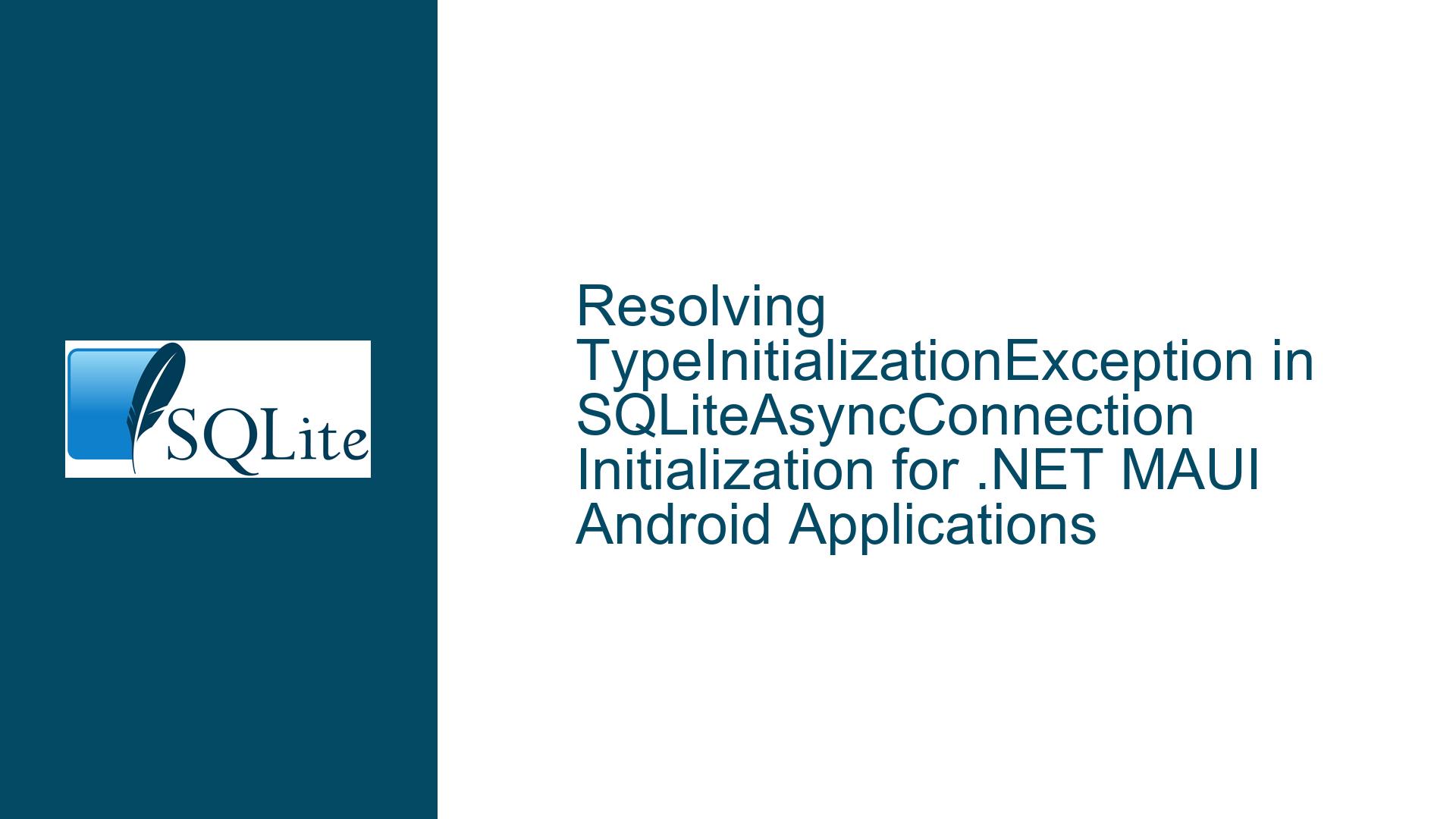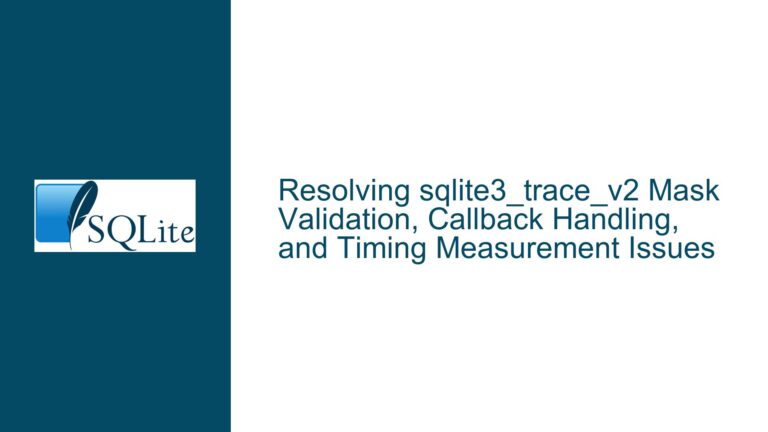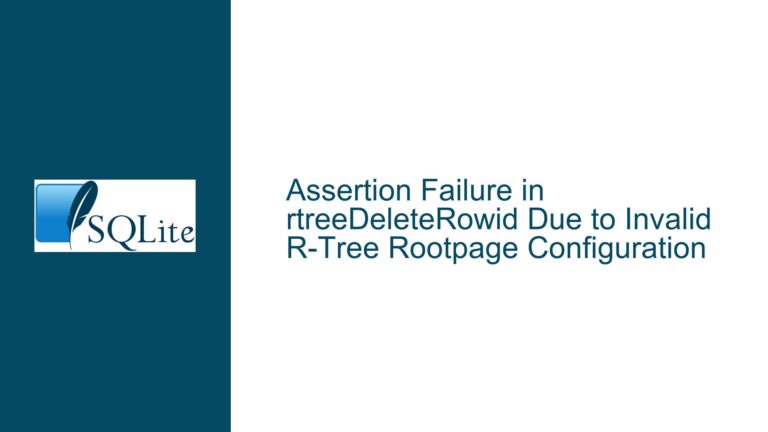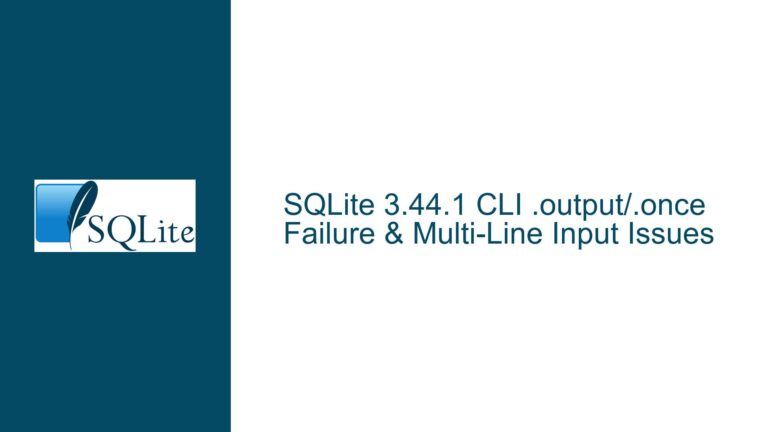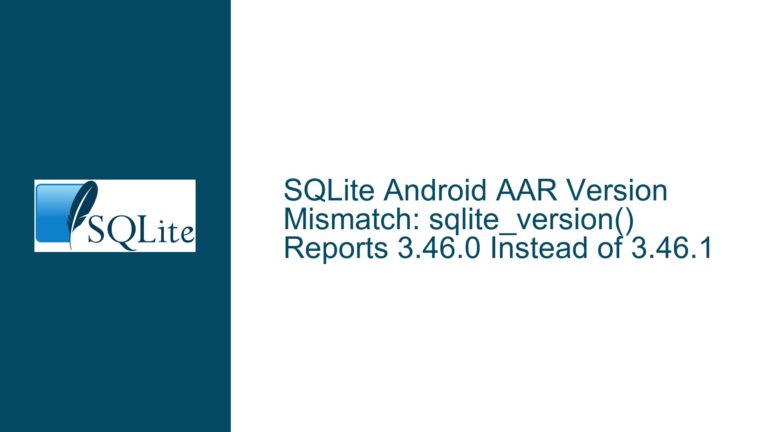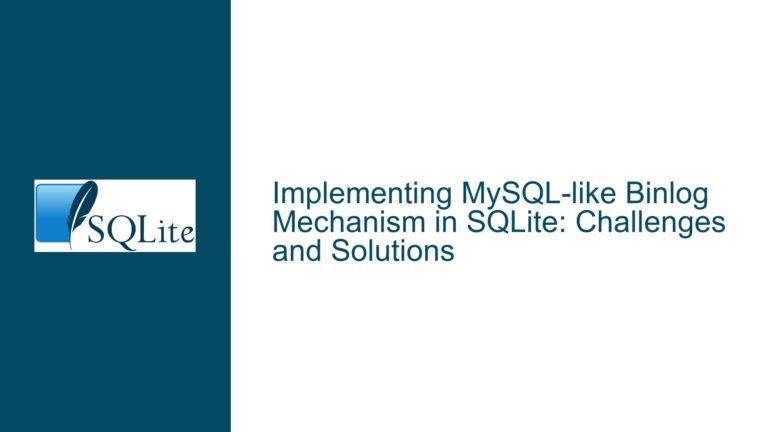Resolving TypeInitializationException in SQLiteAsyncConnection Initialization for .NET MAUI Android Applications
Understanding the TypeInitializationException in SQLiteAsyncConnection Initialization
The core issue revolves around a TypeInitializationException being thrown during the initialization of an SQLiteAsyncConnection in a .NET MAUI application targeting Android. This exception occurs when the type initializer for SQLite.SQLiteConnection fails, leading to an incomplete or failed database connection. The error manifests specifically in the Android environment, while the same code runs without issues on Windows. The exception message indicates that the type initializer for SQLite.SQLiteConnection threw an exception, and further investigation reveals an inner exception stating that the assembly SQLitePCLRaw.provider.dynamic_cdecl or one of its dependencies could not be loaded.
The TypeInitializationException is a critical error that occurs during the static initialization of a type, meaning it happens when the runtime attempts to initialize the SQLite.SQLiteConnection class. This initialization failure prevents the SQLiteAsyncConnection from being instantiated, effectively halting any database operations in the application. The issue is particularly perplexing because it does not occur in the Windows version of the application, suggesting an environment-specific dependency or configuration problem.
The error message provides a crucial clue: the inability to load the SQLitePCLRaw.provider.dynamic_cdecl assembly. This assembly is part of the SQLitePCLRaw library, which is a dependency of the sqlite-net-pcl library used in the application. The SQLitePCLRaw library is responsible for providing platform-specific implementations of SQLite, and its failure to load indicates a mismatch or missing component in the Android environment.
Diagnosing the Root Causes of the TypeInitializationException
The root cause of the TypeInitializationException can be traced to several potential issues, each of which must be carefully examined to resolve the problem. The first and most likely cause is an incompatibility or missing dependency in the Android environment. The SQLitePCLRaw.provider.dynamic_cdecl assembly is a platform-specific component that must be correctly configured for the target environment. If this assembly is missing or incompatible, the type initializer for SQLite.SQLiteConnection will fail, resulting in the observed exception.
Another potential cause is the version of the sqlite-net-pcl library being used. The discussion mentions using version 1.8.116, which may have introduced changes or dependencies that are not fully compatible with the Android environment. Versioning issues are common in cross-platform development, where different platforms may require different versions of libraries or dependencies. It is also possible that the SQLitePCLRaw library, which is a dependency of sqlite-net-pcl, has undergone changes that affect its compatibility with Android.
The third potential cause is related to the deployment and packaging of the application. The discussion mentions that the application embeds a pre-existing SQLite database and moves it to the local store for use by the app. This process involves file operations that may fail or behave differently in the Android environment, leading to issues with database access. Additionally, the way the application references and loads the SQLite libraries may differ between Windows and Android, resulting in the observed exception.
Finally, the issue may be related to the configuration of the Visual Studio project or the Android emulator. The discussion mentions using the Android emulator provided by Visual Studio 2022, which may have specific requirements or limitations when it comes to SQLite and its dependencies. Misconfigurations in the project settings, such as incorrect references or missing files, can also lead to the TypeInitializationException.
Comprehensive Troubleshooting Steps and Solutions for Resolving the TypeInitializationException
To resolve the TypeInitializationException and ensure the SQLiteAsyncConnection initializes correctly in the Android environment, a systematic approach is required. The following steps outline a comprehensive troubleshooting process, including potential solutions and fixes.
Step 1: Verify and Update Dependencies
The first step is to ensure that all dependencies, including sqlite-net-pcl and SQLitePCLRaw, are correctly referenced and up to date. Begin by checking the version of sqlite-net-pcl being used. The discussion mentions using version 1.8.116, but it may be necessary to revert to a previous version, such as 1.6.292, which has been reported to work in similar scenarios. This can be done by modifying the NuGet package reference in the project file or using the NuGet Package Manager in Visual Studio.
Next, verify that the SQLitePCLRaw library and its dependencies are correctly installed and referenced. The SQLitePCLRaw.provider.dynamic_cdecl assembly is a critical component, and its absence or incompatibility can lead to the TypeInitializationException. Ensure that the correct version of SQLitePCLRaw is being used and that all required dependencies are included in the project.
Step 2: Configure Platform-Specific Settings
Given that the issue is specific to the Android environment, it is essential to configure platform-specific settings correctly. This includes ensuring that the SQLitePCLRaw library is correctly configured for Android. The SQLitePCLRaw library provides platform-specific implementations, and the correct provider must be selected for the target environment.
In the case of Android, the SQLitePCLRaw.provider.dynamic_cdecl provider is typically used. However, if this provider is not available or compatible, it may be necessary to use an alternative provider, such as SQLitePCLRaw.provider.e_sqlite3. This can be done by modifying the initialization code to specify the correct provider:
SQLitePCL.Batteries_V2.Init();
This line of code ensures that the correct provider is initialized for the target platform. Additionally, verify that the SQLitePCLRaw library is correctly referenced in the Android project and that all required files are included in the build.
Step 3: Check File Operations and Database Deployment
The discussion mentions that the application embeds a pre-existing SQLite database and moves it to the local store for use by the app. This process involves file operations that may fail or behave differently in the Android environment. To ensure that the database is correctly deployed and accessible, verify the following:
- The database file is correctly embedded in the application and can be accessed using the
GetManifestResourceStreammethod. - The target directory in the local store is correctly specified and accessible. The
Environment.SpecialFolder.LocalApplicationDatadirectory is typically used for this purpose. - The file operations, including copying the database from the embedded resource to the local store, are correctly implemented and do not throw exceptions.
If any of these steps fail, it may be necessary to debug the file operations and ensure that the database is correctly deployed and accessible in the Android environment.
Step 4: Debug and Capture Detailed Exception Information
To gain further insight into the TypeInitializationException, it is essential to capture detailed exception information, including the inner exception. Modify the exception handling code to capture and display the inner exception message:
try
{
connection = new SQLiteAsyncConnection(dbOptions);
}
catch (TypeInitializationException ex)
{
var message = ex.InnerException?.Message ?? ex.Message;
// Log or display the message for further investigation
}
This code captures the inner exception message, which provides more detailed information about the root cause of the TypeInitializationException. Use this information to identify and address the underlying issue.
Step 5: Test on Physical Devices and Different Emulators
The issue may be specific to the Android emulator provided by Visual Studio 2022. To rule out emulator-specific issues, test the application on physical Android devices and different emulators. This helps identify whether the issue is related to the emulator configuration or a broader compatibility problem.
Step 6: Review and Update Project Configuration
Finally, review the project configuration in Visual Studio to ensure that all settings are correctly configured for the Android environment. This includes verifying that the Copy Local property is set to True for all required references, ensuring that the correct target framework is selected, and checking that all necessary files are included in the build.
By following these steps, the TypeInitializationException can be systematically diagnosed and resolved, ensuring that the SQLiteAsyncConnection initializes correctly in the Android environment. This comprehensive approach addresses potential issues with dependencies, platform-specific configurations, file operations, and project settings, providing a robust solution to the problem.
